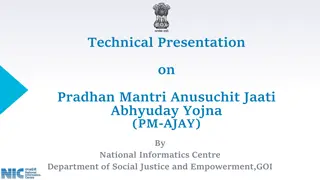Incremental Development Scheme: Khuda-ki-Basti
Khuda-ki-Basti is an incremental development scheme initiated in 1987 by Mr. Tasneem Siddiqui to provide affordable housing solutions to low-income groups in Pakistan. The scheme allows families to acquire land and services gradually based on their paying capacity, encouraging incremental development of housing and infrastructure. Through a unique approach, Khuda-ki-Basti aims to address the housing needs of the most vulnerable sections of society, promoting sustainable urban development.
Download Presentation

Please find below an Image/Link to download the presentation.
The content on the website is provided AS IS for your information and personal use only. It may not be sold, licensed, or shared on other websites without obtaining consent from the author.If you encounter any issues during the download, it is possible that the publisher has removed the file from their server.
You are allowed to download the files provided on this website for personal or commercial use, subject to the condition that they are used lawfully. All files are the property of their respective owners.
The content on the website is provided AS IS for your information and personal use only. It may not be sold, licensed, or shared on other websites without obtaining consent from the author.
E N D
Presentation Transcript
KHUDA KI BASTI (An Incremental Development Scheme)
Introduction In 1987, Mr. Tasneem Siddiqui, a civil servant, who at the time was the Head of Hyderabad Development Authority (HDA), launched a micro-housing scheme titled Incremental Developmental Housing Scheme on the concept of incremental or progressive housing. The scheme was initially implemented and managed by HDA, the public sector institution. Later on, an NGO that was associated with the project management was registered as SAIBAN in 1990. Mr. Tasneem Siddiquie founded SAIBAN, with an initiative to meet housing needs of very poor and very needy sections of the society who are the real candidates for micro-housing solutions. The HBFC, public sector housing finance institution with a business focus on Small and Medium Housing finance came forward to provide micro-housing loans to these people. SAIBAN launched housing schemes in Hyderabad, Karachi and Lahore based on the concept of Incremental or Progressive Housing. Under this scheme, a poor and needy family is invited to personally visit the reception of KKB on site.
Objectives of the scheme The basic objective of the Khuda-ki-Basti scheme include the following: To make land for housing available at an affordable price to low-income groups. To help them acquire services incrementally over time, and at a pace determined by their paying capacity. To make this possible meant a major departure from the manner in which the public sector operates in the housing sphere and the development of a new and innovative approach.
KKB-Hyderabad In 1987, the first scheme (KKB-1) was allotted 190 Acres of land in Gulshane Shahbaz, Hyderabad, which was subdivided into 3,180 plots of size 80 Sq.yards. Later another small size scheme (KKB-2) of 100 plots was launched in Hyderabad. In an attempt to reach the lowest income groups in Hyderabad, HDA launched an incremental development scheme. The scheme is based on the idea that people should settle before houses and infrastructure are constructed and that, once settled, they can develop their housing and the infrastructure incrementally, as and when they have the resources. The incremental development scheme in Hyderabad imitates the approach followed by the illegal subdividers: It is characterized by ease of entry, Immediate delivery of the plot, and Incremental development of the houses and the infrastructure. HDA initially recruited illegal subdividers to assist the agency in the identification and settling of low income families in the incremental development scheme.
Introduction The scheme, KKB provides initially only 80 square yard plots and water supply through water tankers. HDA requires a low income family in need of shelter to spend, initially, two weeks in a reception area to prove its urgent need for shelter. Then, the HDA allocates a plot upon the payment of Rs.1000 (US$30) which covers the full cost of the plot. The family has to live on the plot permanently. The plot is repossessed if found unoccupied; this reduces absentee ownership and speculation. HDA does not set any standards for housing, and this enables the allottees to build their houses according to their individual needs and resources. Once settled, the allottee is urged to make regular payments into a neighbourhood account, so that the provision of infrastructure can be financed, once sufficient funds have been accumulated. This eliminates the need for cost recovery.
Hardships and Disadvantages (KKB-Hyderabad) A disadvantage of KKB is its location, about half an hour from the city of Hyderabad by public transport. The industrial zone of the Sindh Industrial Trading Estate is not far away, but the project's low income families, who earned their daily income mainly from informal-sector activities in Hyderabad, faced quite some hardship when they settled in KKB. Furthermore, residents of KKB had to travel regularly to Hyderabad in the initial phase of the scheme, when the settlement did not have many shops and public services; this made transport one of the costliest items in their budget. Fortunately, conditions are gradually improving, with the settlement of more households and the growth of the commercial and small industry sector.
Initial Success of the Scheme Although there is need for improvement of the approach, the results of the first three years of the incremental development scheme are quite encouraging. Some 2800 families have settled in KKB and many have been able to construct semi-permanent houses. In those blocks which have been able to develop a strong community organization, water supply, a sewer system and electricity are already available. Other blocks have, however, not been able to develop any infrastructure, owing to a lack of leadership: if they can not manage soon to acquire some basic infrastructure without an up-front payment and re-introduce the need for cost recovery. It is essential for the success of the scheme that the population be organized at block level and be urged to make regular payments into the block account for infrastructure. An agency, such as the HDA does not have the capacity to develop and organize communities, and to train local leaders.
Sequence of Settlement Therefore, for the success of such a scheme, it would probably be best to settle existing low income communities, rather than individual families, or to organize communities before settlement. This would imply the following sequence of settlement: PEOPLE--> LAND--> HOUSING--> INFRASTRUCTURE Once the allottees have been settled, the housing agency could hand over the scheme to a non-governmental organization (NGO) and the NGO could organize the communities, train leaders, assist the population to save money for infrastructure and advise the community to construct the infrastructure on a self-help basis, as is being done in the Orangi Pilot Project, Karachi.
KKB-Karachi The KKB-3 project was initiated by SAIBAN in 1999 near Surjani Town in association with Malir Development Authority (MDA). The project was implemented in two phases. Phase-1 consisted of 60 Acres and Phase-2 of 40 Acres, with a total land area of 100 Acres. The scheme developed 2,856 plots of 80 Sq. Yards each. Today the KKB-3 has a population of about 20,000 people. The average cost of the plot was Rs 40,000 wherein 25 % was to be paid in advance and the balance in easy monthly installments. The scheme was developed in strict compliance with prevailing laws of Town Planning, with ample provision for schools, hospitals/dispensaries, places of worship, community centers, play grounds and commercial areas. The residential infrastructure was also provided right at the initial stage.
KKB-Lahore The KKB-4 project in Lahore was started by SAIBAN in association with Acumen Fund of USA. At present it consists of 20 Acres of land, and efforts are being made to procure more land in the adjoining area. The layout plan of KKB-4 is based on a community concept that is divided into blocks of 23 housing units each, and a park in the center of each block. In order to ensure greenery and conserve water, the Scheme is equipped with water recycling facilities as well.
Achievements of the Scheme The Khuda-ki-Basti scheme was really a pilot project aimed at identifying land delivery and development models that could overcome the constraints faced by public sector policies in serving the shelter needs of the lower-income groups in Pakistan. To fulfill its objectives the scheme has innovated, borrowed from informal sector strategies and NGO programmes and sought support from government social sector programmes and international agencies.
Reasons behind the achievement The reasons for the success of the project include: The authors of the programme had acquired knowledge of existing government policies related to housing and their inappropriateness and constraints, informal sector strategies and operators, various NGO programmes related to development and had a commitment to discovering relevant alternative models of development. Constant monitoring of the development and settlement process in the basti took place so as to modify changes in procedures and strategy and to respond to the needs of the settlement as and when such needs arose. The transfer of the vision of the Khuda-ki-Basti development model to the HDA staff, which in turn motivated them to take on a role in the process not normally enacted by government officials.
Reasons behind the achievement The need of low-income groups to find shelter, their willingness to put up with hardships to fulfil this need, and their ability and potential to respond to initiatives taken in this regard, especially if these initiatives bear the seal of the government or its approval. The willingness on the part of the HDA to innovate; bend HDA rules and regulations to suit its objectives, and to attempt to shed deep-rooted prejudices that government agencies (and even NGOs) have towards low-income communities.
Findings of the Project As a result the project has, in spite of certain problem areas, demonstrated that: Land at an affordable price can be delivered to the urban poor without subsidy and without burdening the state. Services can be acquired in a short period of time by local communities if proper representative organizations, supported and backed by government administrative machinery, are created and allowed to develop. Social sector and income generation facilities can be acquired through existing government, international agencies and NGO programmes, provided the implementing agency has knowledge of them and they are intelligently tapped. The whole process of development can be aided by understanding and promoting the organizational, managerial and technical potential and capacity of local middlemen, entrepreneurs and the residents.

 undefined
undefined






























